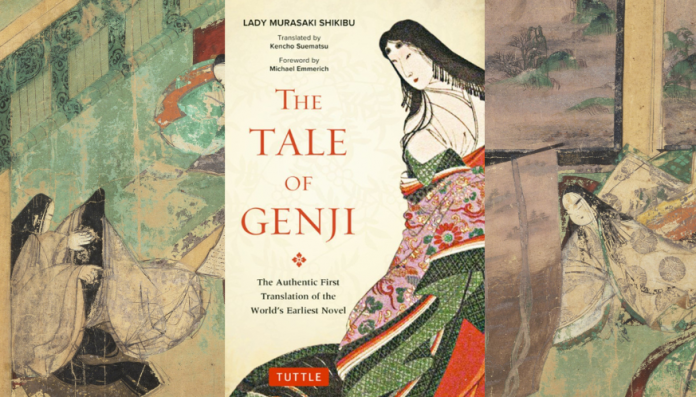“At the Court of an Emperor (he lived it matters not when) there was among the many gentlewomen of the Wardrobe and Chamber one, who though she was not of very high rank was favoured far beyond all the rest.”
Widely regarded as one of the greatest works of Japanese literature, The Tale of Genji by Murasaki Shikibu is a Monogatari (a traditional Japanese prose literary form akin to a western epic novel in scope) with the purported, albeit challenged distinction of being the world’s first novel.
A substantial amount is known about Murasaki Shikibu, perhaps unusually so for a non-royal historic figure from over 1000 years ago. This vast biographical knowledge is due to a collection of diary fragments known collectively as The Diary of Lady Murasaki. Although her real name is unknown, we know Lady Murasaki was born in c. 973, died in c. 1014 or c. 1025 and that she was a Heian period Japanese novelist, poet, and lady-in-waiting at the Heian Imperial court.
The Tale of Genji is an immersive dive into early Heian period court life, written between c. 1000 and c. 1008, the novel recounts the life and adventures of the incomparably beautiful and genius Shining Prince Hikaru Genji, the son of a Japanese emperor and his favourite concubine, who has been consigned by the emperor to civilian life for a multitude of political reasons.
The core of this epic focuses on Genji’s family circumstances, love affairs, and his shifting political alliances and personal fortunes; however, the text is so much more than this, it is a fairly comprehensive introduction to medieval Japanese court culture, and an exquisitely written treatise on human emotion and natural beauty.
The Tale of Genji does not follow a unified narrative arc, instead, like many beloved western epics, the tale is composed of a series of overlapping events in an episodic format. Furthermore, although not trisected in the text, many contemporary literary critics view the text in three unique parts, the first and the largest concerns Genji’s early life and successes, the second on Genji’s later life and reminiscences, and the third on the lives of several descendants of Genji.
Like the subject of 50 Books (2), Os Lusíadas, the difficulty and ultimately the reader’s experience of the novel can be significantly affected by the translation ‒ particularly intelligible and enjoyable translations of The Tale of Genji (to the contemporary palate) include Royall Tyler’s (2001) and Dennis Washburn’s (2015).
The Tale of Genji is immense, it has over 400 characters, 795 expertly composed waka poems, and with English translations coming in at 54 chapters and close to 1200 pages, it is not for those looking for physically or intellectually light reading ‒ merely lifting an edition is a workout in itself; however, if a prospective reader can dedicate themselves to the novel, it really is an interesting read and one unlike what most Euro/Americentric readers will ever encounter.
“That appears to be what is in the book.”
This review of The Tale of Genji by Murasaki Shikibu is the fourth instalment of a fortnightly series called 50 Books. The series shines a spotlight on classical literature from throughout history and all over the world. If you have suggestions for future instalments comment and let me know.
Next time: The Nigerian classic, Things Fall Apart by Chinua Achebe.
Words by Luke Horwitz
Want more Books content from The Indiependent? Click here!
Support The Indiependent
We’re trying to raise £200 a month to help cover our operational costs. This includes our ‘Writer of the Month’ awards, where we recognise the amazing work produced by our contributor team. If you’ve enjoyed reading our site, we’d really appreciate it if you could donate to The Indiependent. Whether you can give £1 or £10, you’d be making a huge difference to our small team.
